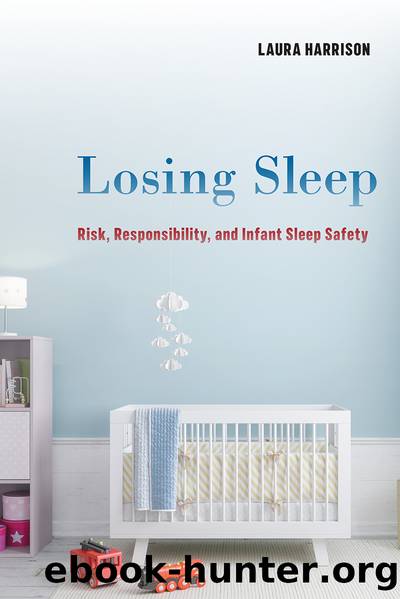Losing Sleep by Laura Harrison

Author:Laura Harrison [Harrison, Laura]
Language: eng
Format: epub
Tags: SOC057000 SOCIAL SCIENCE / Disease & Health Issues
Publisher: NYU Press
Jenna and Adam
Jenna and Adam, 30 and 24 years old respectively, were living in the Midwest when they were each charged with felony and misdemeanor counts of child endangerment. Both parents were under the influence of alcohol and marijuana when their four-month-old died while sharing a bed with them. The couple had a history of investigations by Social Services regarding the four children who lived in the home. Both pled guilty to misdemeanor child endangerment, and both received 180 days in jail, with 90 days stayed, and two years of probation.
The most pervasive commonality between the 29 cases that I gathered was the parental use of drugs or alcohol. Of the 29 cases, in 23 at least one of the caregivers either admitted to or tested positive for using alcohol or illegal drugs before co-sleeping with the child. In three of the remaining six cases, news reports noted that drugs were found in the home, or that the accused had a history of drug or alcohol abuse.62 The severity of the substance abuse varied within the data set, and is also difficult to quantify due to the nature of these cases. Because SUID typically occurs at night, when families are asleep, law enforcement may be testing parents for substance use many hours after the death of the infant. Some parents were clearly impaired by âhardâ drugs such as heroin while sleeping with their children, while others are reported as having a history of drug or alcohol abuse.
Given these limitations, this research could not identify the exact narcotics used in each instance, but opioid use was evident in multiple cases. These include synthetic opioids such as hydrocodone and oxycodone (often known by its brand name, Oxycontin) as well as heroin and morphine. The time period in which these cases occurred also coincides with an opioid epidemic in the United States. The CDC divides the opioid epidemic into three waves; the first beginning in the 1990s as prescriptions of opioids increased, the second wave initiated in 2010 and marked by heroin overdoses, and the third wave starting in 2013 and notable for overdoses of synthetic opioids. Currently, an average of 130 people in the United States die per day due to opioid overdose.63 For years, pharmaceutical companies pushed physicians to prescribe more opioids to more patients, and research indicates that 80 percent of those who abuse opioids had a prescription for these medications before their abuse began.64
The opioid crisis is reflective of how deadly the neoliberal rhetoric of individual choice and personal responsibility can be. The response to the crisis is slowed by lawmakers who hesitate to approve funding for treatment and first response measures due to stigma and stereotypes about addiction, while the pharmaceutical companies that manufacture synthetic opioids continue to profit. Stigma surrounding opioid and other illegal drug use is particularly strong for pregnant women and mothers; using these substances garners greater social censure, regardless of harm, than alcohol or tobacco.65 More than eight times as many women are incarcerated
Download
This site does not store any files on its server. We only index and link to content provided by other sites. Please contact the content providers to delete copyright contents if any and email us, we'll remove relevant links or contents immediately.
Nudge - Improving Decisions about Health, Wealth, and Happiness by Thaler Sunstein(7239)
iGen by Jean M. Twenge(5158)
The Fire Next Time by James Baldwin(5015)
Adulting by Kelly Williams Brown(4231)
The Hacking of the American Mind by Robert H. Lustig(4082)
The Sports Rules Book by Human Kinetics(4075)
The Ethical Slut by Janet W. Hardy(4036)
Captivate by Vanessa Van Edwards(3722)
Mummy Knew by Lisa James(3519)
In a Sunburned Country by Bill Bryson(3363)
The Worm at the Core by Sheldon Solomon(3325)
Ants Among Elephants by Sujatha Gidla(3278)
Suicide: A Study in Sociology by Emile Durkheim(2902)
The Slow Fix: Solve Problems, Work Smarter, and Live Better In a World Addicted to Speed by Carl Honore(2837)
The 48 laws of power by Robert Greene & Joost Elffers(2801)
Humans of New York by Brandon Stanton(2683)
Handbook of Forensic Sociology and Psychology by Stephen J. Morewitz & Mark L. Goldstein(2603)
The Happy Hooker by Xaviera Hollander(2582)
The Tipping Point by Malcolm Gladwell(2554)
